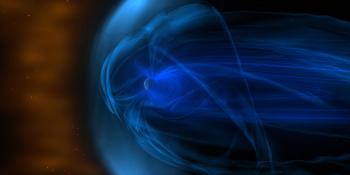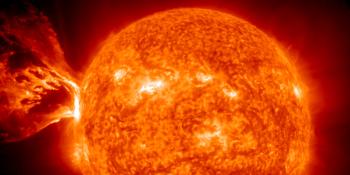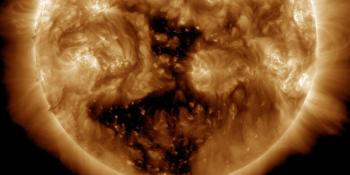Viewing archive of Monday, 18 March 2002
Solar activity report
Any mentioned solar flare in this report has a scaling factor applied by the Space Weather Prediction Center (SWPC). Because of the SWPC scaling factor, solar flares are reported as 42% smaller than for the science quality data. The scaling factor has been removed from our archived solar flare data to reflect the true physical units.
Report of Solar-Geophysical Activity 2002 Mar 18 2200 UTCPrepared by the NOAA © SWPC and processed by SpaceWeatherLive.com
Joint USAF/NOAA Report of Solar and Geophysical Activity
SDF Number 077 Issued at 2200Z on 18 Mar 2002IA. Analysis of Solar Active Regions and Activity from 17-2100Z to 18-2100Z
Solar activity was moderate. Activity in the vicinity
of Region 9866 (S09W46) was associated with a long duration M1 flare
which began at 0216 UTC and ended at 0400 UTC. Also associated with
this event were a type IV sweep and a halo CME visible in LASCO
imagery. Region 9866 continues to decay slowly. C-class flare
activity was observed from Region 9870 (S20W39) which appears to
have some new, opposite polarity flux emergence. Region 9871
(S19E07) produced a C8/1f flare at 1918 UTC and is currently the
largest region on the disk.
IB. Solar Activity Forecast
Solar activity is expected to be
moderate. Regions 9866 and 9871 are considered to be the most likely
sources for M-class flares. There is a slight chance for a major
flare during the next three days.
IIA. Geophysical Activity Summary 17-2100Z to 18-2100Z
The geomagnetic field was quiet until 1323 UTC when a strong sudden
impulse (SI) was observed. The SI measured 42 nT on the Boulder
magnetometer. The SI followed the passage of a shock at ACE at 1237
UTC. The post shock flow at ACE consisted of enhanced magnetic
fields but so far they have been predominantly northward.
Geomagnetic activity subsequent to the SI has been unsettled to
active. The greater than 10 MeV proton event that began at 17/0820
UTC officially ended at 17/1230 UTC, but flux levels remained
enhanced thereafter. With the arrival of the shock the protons once
again reached event level, beginning at 19/1300 UTC. The maximum
flux observed so far was 25 PFU at 19/1535 UTC.
IIB. Geophysical Activity Forecast
The geomagnetic field is
expected to be mostly active for the next 24 hours, with a chance
for some isolated minor storm periods. After the current transient
flow subsides there should be a lull in activity, but another shock
is expected to arrive near mid-day (UT time) on the 20th in response
to today's halo CME. Activity following this shock is expected to be
mostly active. Conditions should subside to unsettled sometime on
the third day. The greater than 10 MeV proton event is likely to end
sometime in the next 12 hours.
III. Event Probabilities 19 Mar to 21 Mar
| Class M | 55% | 55% | 55% |
| Class X | 10% | 10% | 10% |
| Proton | 30% | 10% | 10% |
| PCAF | yellow | ||
IV. Penticton 10.7 cm Flux
Observed 18 Mar 178 Predicted 19 Mar-21 Mar 180/175/175 90 Day Mean 18 Mar 214
V. Geomagnetic A Indices
Observed Afr/Ap 17 Mar 002/004 Estimated Afr/Ap 18 Mar 015/012 Predicted Afr/Ap 19 Mar-21 Mar 020/020-020/020-015/015
VI. Geomagnetic Activity Probabilities 19 Mar to 21 Mar
| A. Middle Latitudes | |||
|---|---|---|---|
| Active | 35% | 35% | 30% |
| Minor storm | 25% | 25% | 20% |
| Major-severe storm | 10% | 10% | 05% |
| B. High Latitudes | |||
|---|---|---|---|
| Active | 35% | 35% | 30% |
| Minor storm | 25% | 25% | 20% |
| Major-severe storm | 15% | 15% | 10% |
All times in UTC
Latest news
Latest forum messages
AR4073 1AR 4065 13Ask your obscure/"stupid" space weather questions. 376AR4064 29Filaments and prominences 106
More topicsSupport SpaceWeatherLive.com!
A lot of people come to SpaceWeatherLive to follow the Sun's activity or if there is aurora to be seen, but with more traffic comes higher server costs. Consider a donation if you enjoy SpaceWeatherLive so we can keep the website online!

Space weather facts
| Last X-flare | 2025/03/28 | X1.1 |
| Last M-flare | 2025/04/22 | M1.3 |
| Last geomagnetic storm | 2025/04/21 | Kp5+ (G1) |
| Spotless days | |
|---|---|
| Last spotless day | 2022/06/08 |
| Monthly mean Sunspot Number | |
|---|---|
| March 2025 | 134.2 -20.4 |
| April 2025 | 122.8 -11.4 |
| Last 30 days | 117.7 -15.6 |


